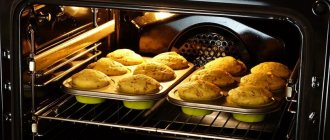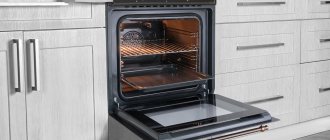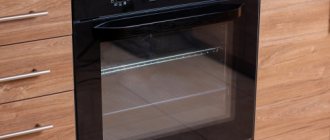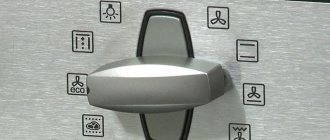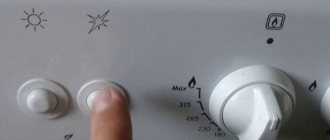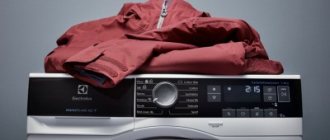Convection in Latin means “transfer.” In this case, it is the exchange of hot and cold air in the oven. In other words, the hot air flow rises to the top, and the cold air flows down. After some time, the temperature throughout the oven becomes the same.
In almost all old ovens, convection was “natural”, that is, heat exchange occurred, but it took a very long time. Housewives had to pull out a sheet of food and turn it over so that the dish would bake evenly. With meat dishes, such manipulations took place without consequences, but baking a high-quality sponge cake or meringue was almost impossible. Now, many ovens have “forced” convection; baking anything has become much more convenient, since the air is distributed evenly.
Principle of operation
Convection in the oven is carried out thanks to a fan installed in it. Its usual location is the back of the oven wall, from where it disperses the air inside. Its task is to achieve the required temperature. After the task is completed, the fan turns off.
Convection can be used in both electric and gas ovens. The advantages of gas ones are that they consume much less electricity. The main heating is carried out from below, so convection in such models is extremely necessary.
Content
There are three types of heat transfer: conduction, convection and radiation. In the last lesson you learned about thermal conductivity. With this phenomenon, internal energy is transferred from one part of the body to another or from one body to another. This is closely related to the structure of the substance in question and the thermal movement of particles in it.
When we talk about convection, we will not be talking about the movement of individual particles, but about the movement of groups of particles . In this lesson we will find out the defining difference between the phenomenon of convection and thermal conductivity and give it a definition. Next, we will consider convection in liquids and gases, we will learn this phenomenon in everyday examples and in nature.
Designation of convection modes
You can usually see the oven modes on the control panel. Convection itself is indicated by a fan icon, and there may also be additional functions. Eg:
- A horizontal line below the fan means bottom airflow
- Top line - top blowing
- Bottom and top line - simultaneous top and bottom blowing
- With a zigzag on top means airflow and grill mode
- Fan icon with "Eco" label listed as humid convection
Convection in the oven: what is it?
In older oven models, burners (gas) or heating elements (electric) were located only at the bottom, and the top of the baked goods was browned due to natural convection - the movement of heated air and heat exchange in the closed space of the oven. The results were often disappointing: the bottom was burnt and the food was unevenly baked. I had to take out the baking sheets, turn them in different directions, and place a container of water on the bottom of the oven.
The baking process used to require constant monitoring - periodically opening the oven door and checking the readiness of the dough with a wooden stick.
New oven models, as a rule, are also equipped with heating from above, which greatly simplifies the baking process and allows you to cook dishes on the grill. But even with combined heating (bottom and top), natural convection may not be enough for perfect baking. The fact is that normal heat exchange in the oven occurs rather slowly; certain factors can interfere with it: a door that does not close tightly or opens it frequently, as well as large baking sheets that occupy the entire width of the oven and interfere with air circulation.
Convection (from Latin convectio - transfer) is a natural heat exchange in which internal energy is transferred by flows and jets. Warming air rises and cold air falls down. In an oven, when layers of air are mixed more quickly due to convection, the temperature immediately becomes the same on all levels.
Now any housewife can appreciate the advantages of ovens with forced convection, that is, air circulation created using a built-in fan. It is usually located on the back wall of the oven and turns on separately when certain modes or preset programs are selected.
The fan built into the back wall of the oven provides forced convection
Various oven manufacturers offer improved convector designs that have additional features: fans with a separate heating circuit, reinforced fans to create a rapid flow of hot air, moist convection mode for steaming dishes without the use of fats.
So, we’ve sorted out the question of what convection in an oven is, and now we’re moving on to the most interesting part: what is convection in an oven for?
Wet convection mode
An oven with this mode is simply a real find for those who are in favor of proper nutrition. After all, in this mode you can prepare many different delicious and dietary dishes. The principle of its operation is that dishes are prepared by being evenly blown from all sides with moist hot steam. This affects cooking time and food quality. Steam is created due to the fact that such ovens have special built-in containers into which clean water is poured. As a result, the dishes are tasty, juicy, not overdried, and most importantly, all vitamins are retained.
Types of convection
Several types of airflow are available. Depending on how “polished” the manufacturer is and what mechanism his product is equipped with, there are 2 main types of convection - dry and wet.
Dry
Dry air is most often used in an electric or gas oven with a convector. It was described earlier - it is a simple (or reinforced) fan surrounded by heating elements.
Wet
This interesting solution will especially appeal to those who care about their health and follow the rules of proper nutrition. Externally, a convection device does not differ from analogues with a different type of heat transfer. The difference is a special water container located inside the oven. Heating the liquid causes evaporation, so you can steam it. The container is attached to the back wall or door.
Latest models with humidity control. You can manually set the operating mode to hot steam (25%), intense (50%), wet (100%) - evaporation.
Advice! Steamed food retains all useful microelements and vitamins. After removing the baking sheet, you can cook in the standard mode.
Reinforced
There is also this type of double convection. From the name it follows that the air flow is stronger, the stove heats up very quickly, the meat quickly becomes crusty, remaining juicy inside.
Grill with convection
Have you heard the term “air grill”? If you haven't thought about it before, you know that this is a grill with a built-in fan. This tandem of options provides excellent tasting dishes. Compared to traditionally prepared products, this alternative has the following benefits:
- food does not burn;
- does not dry out;
- maintains softness and juiciness;
- bakes evenly;
- large pieces of meat are cooked;
- the meat turns red and has a sharp, crispy crust.
Combi ovens are no longer a rarity. But if you want to buy the 2-in-1 option (thermostat grille), be sure to consult with the seller.
Advantages of convection ovens
Undoubtedly, ovens with a similar mode have a lot of advantages. In such cabinets you can prepare many different dishes, and even use them as a sterilizer.
Pros:
- Even distribution of air throughout the oven
- Ability to cook several dishes at once
- Minimum gas and electricity consumption
- Additional modes such as drying, defrosting
This mode can be used for drying fruits, nuts, meat, and crackers. You can also use it to defrost food. If you turn on the convection 15 minutes before the dish is ready, it will be covered with a golden crust.
Different types of plates and mode features
Every housewife has experience working with an electric or gas stove, oven, or microwave.
If the devices differ in type and technical parameters, what is the difference in convection heating characteristics?
Electric oven and convection
Modern ovens with a built-in thermostat are divided into 2 groups: electric and gas. In both cases there is chamber lighting. But in an electric stove, unlike a gas stove, the heating elements are located at the top and bottom.
Attention. Innovative models are often released with enhanced functionality. The new generation oven has built-in working elements - a spit and a grill. Thanks to them, the meat becomes evenly baked, soft and juicy, with a crispy golden crust.
Gas stove and convection
Previously, only electric stoves could boast of convection mode. But today the gas stove also has a convection mode. The development was presented by Electrolux, whose employees are not going to stop there.
Only the heaters are located on the side. Typically, 2 heating elements should be placed on the same level on the right and left walls. However, there is a variant of one burner connected to the side plate, which provides high-quality heating of the chamber.
Since most homes have a gas pipeline, about 80% of Russian women buy gas stoves. This means that until recently they could not use convection mode.
Microwave
Owners of vented microwave ovens can learn what convection is and evaluate how it works. The owners of such “helpers,” in addition to their direct purpose, microwave ovens (heating and defrosting dishes), use them for baking cookies, biscuits, baking fish, and meat!
The mechanism is standard: a fan is installed on the back wall of the oven, forcing air into the oven. However, these models are larger than conventional microwave ovens, require additional space, consume more electricity, and are more expensive.
The ideal microwave oven combines 3 functions:
- microwave;
- grill;
- convection.
Heaters are shadow or quartz spirals installed inside the working chamber on the upper wall. The second option is better - quartz heaters are ergonomic, take up little space, are easy to clean, and regulate the degree of heating.
Oven
To answer the question of whether convection is needed in the oven or not, you need to understand the purpose of the purchase (what dishes will be cooked, how often). For women who are not comfortable with a regular cooker, the updated version is essential for getting delicious food rather than tough meat.
The oven combines the concepts of free and forced convection. In the first case, the movement of air masses is involuntary and arises due to the inhomogeneous density of the medium caused by the action of external forces. Natural heat exchange is a long process and does not change the fact that the trays are moving, so there was a “forced” heat exchange.
The duration of natural air distribution is affected by: loosely closed doors, frequency of opening the oven to control the baking process, massive large baking sheets that take up a lot of space and prevent the free circulation of air masses.
Built-in convector circulating air is activated separately when selecting programs; the entire volume of the furnace is used. Manufacturers are optimizing the mechanisms of convectors, offering the ability to create fast air flow using reinforced fans, the presence of a separate heating circuit, and a wet cooking mode to produce steamed dishes cooked without oil.
Safety of installation and operation
All models of gas ovens have several systems that ensure safe operation. So, the door glazing is made multi-layered so that the scalding temperature does not reach the outer surface of the door. So that even a child looking through the “porthole” at a chicken rotating on a spit will not get burned. He will not be able to participate in controlling the oven and opening the door, thanks to the lock.
In addition, as mentioned above, heat is removed from the surface of the oven by an internal electric fan.
The control panel of a gas device is much simpler than that of an electric one. In addition to the timer (1), the panel contains a temperature regulator (2) and a mode switch (3). Power on indicator (4)
The gas supply is blocked automatically if:
- the burner goes out accidentally;
- a gas leak occurs;
- The pressure in the gas line drops.
To install a gas oven, you must invite a specialist. He will not only safely connect the gas, but will also check the compliance of the technical device with the type of gas (natural or liquefied) and, if necessary, replace the nozzle.
Additionally, it is necessary to install exhaust equipment. To connect to the electrical network and gas, you need to contact specialists.
The electrical outlet must be of the correct type and must be grounded. In addition to the above, it is necessary to take measures to ensure free access to the oven and its removal. Therefore, it is important link_webnavoz]to properly prepare the place[/link_webnavoz].
Rules for using the mode
If you're unsure whether you need convection, pay attention to the ease of use of this feature. This mode is activated at different stages of cooking depending on what is being cooked. For example, when baking bread, rolls, or cookies, it is necessary to finally activate the convection function after the dough is ready. If you turn it on first, the top of the dough will quickly become crispy and will not allow the rest of the mixture to rise. The shell will eventually crack, ruining the presentation.
Fatty meat (duck) requires inclusion immediately after immersion in the oven. The main fat is located under the skin. Using this mode will speed up the heat transfer, the fat will dissolve faster and the duck skin will be crispier.
Long-term baking of low-fat varieties (boiled pork, lamb) for 4-5 hours allows the meat to be completely cooked. However, the peel does not appear. Turn on the thermostat 5-7 minutes before removing from the stove and the problem will be solved.
All the secrets of the oven and what you need to know about baking modes?
We are all accustomed to the fact that modern ovens have many different baking modes .
“Convection”, “Top-bottom”, “Top”, “Bottom”, “Grill”, etc. But do we use them all and do we know about their purpose and main differences?
Let's figure out today which modes are the most important for confectioners and what we need to remember when we change one mode to another.
Let me say right away that we will talk about electric ovens.
Firstly, because most housewives (including me) have them.
And secondly, it’s difficult for me to write about gas ovens as an expert, since I only had experience using such ovens in my youth, that is, 30-35 years ago, and during that time they have changed a lot, I think)).
So, what modes are there in principle in most ovens?
Basic baking modes
Top heating mode , or it is often called simply “Top”, is a mode when only the top heating element works in the oven and, accordingly, the main heat in the oven comes from above. This mode is well suited for obtaining a crust in almost ready-made dishes.
Bottom heating mode (or simply “Bottom”) - in this mode, on the contrary, only the bottom heater works, the mode is good for heating large volume dishes, as well as for stewing.
The upper and lower heating mode (“Top-Bottom”) is a mode when both the upper and lower heaters operate simultaneously, due to which a more uniform heat is created in the oven throughout its entire volume.
“Convection” mode - in this mode, both the upper and lower heaters also work, and at the same time the fan is also turned on, which creates additional blowing of hot air.
The “Grill” mode is a top heating mode, when an additional heating element is turned on, which can create very strong heat in the upper part of the oven. Usually the additional heating element heats up to red and we can see it. This mode is used if you need to get a golden brown crust on top, and turn it on for a few minutes when the dish is almost ready. For example, if you need to get a crust of caramelized sugar when preparing creme brulee, then the “Grill” mode will help us.
Some ovens also have Defrost and Light . The first allows you to turn on the oven at a temperature of 30-40C and is very convenient for melting chocolate. And with the oven lamp on, I often proof the yeast dough.
"Convection" vs "Top-Bottom"
Of course, the modes most used by confectioners are “Top-Bottom” and “Convection”. The fundamental difference between them, as we have already discussed, is the airflow due to the fan. Thanks to this airflow, dishes bake faster and a golden brown crust appears.
If the author of the recipe recommends cooking a dish using the “Convection” mode, but there is no such mode, then turn on “Top-Bottom”, setting the temperature 5-15C higher. That is, if the recipe says that you need to bake at 170C on “Convection”, then this is equivalent to 180-185C “Top-bottom”.
But is it always better to bake using the Convection mode?
Not really. This mode is perfect for baking shortcrust pastry, yeast baked goods and airy classic type sponge cakes.
But for eclairs and other products made from choux pastry , as well as when baking muffins or butter biscuits , it is better to use the “Top-bottom” mode without a fan, since hot airflow often leads to eclairs and muffins cracking and tearing during baking .
Which modes do you use most often? Write in the comments.
Consumer Reviews
Before choosing one or another model, you should pay attention to the reviews.
Review of Zanussi ZLB 331:
More details on IRecommend:
Review of Gorenje BO7454DX:
More details on IRecommend:
Review of the VitekVT-2490W mini-oven:
More details on IRecommend:
Baked goods, juicy meat, grilled fish with vegetables, baked potatoes - all this is the merit of ovens and mini-ovens equipped with a fan. They make life easier for housewives and allow you to diversify the menu. It is worth noting that the prices for ovens and stoves with this function are not much higher than the cost of middle-class appliances without this function. On average, a stove will cost 25,000 rubles.
Oven dishes are tasty and healthy
If you have any questions, be sure to ask them in the comments. We'll be happy to answer them and help you choose the perfect appliances for your home.
How to use convection
Using a convection oven is easy. You just need to correctly determine at what point to enable and disable the function.
When and how to turn it on
It depends on the type of dish. For example, convection promotes the appearance of a crust, which “seals” the juice inside meat or vegetables. Therefore, it is turned on at the very beginning of cooking, and turned off in the middle or end. You should not leave the dish in the oven with a convector for a long time, otherwise it will turn out dry.
When baking bread, the convection mode is turned on only after the dough has baked to give the baked goods a beautiful color.
To turn on convection in the oven, as a rule, you need to set the fan mode. If a horizontal line is drawn above the fan, this means that the upper heating element will turn on simultaneously with convection. Two lines, respectively, mean the operation of two heaters. The teeth indicate the convection grill mode.
Manufacturers may change designations, so it is better to check the instructions for the equipment. It is important to keep the oven clean. If fat or food particles are not removed in time, they can burn and turn into permanent dirt. No time? Order professional maintenance cleaning.
How to turn off
The convection mode in the oven is turned off in two ways. To do this, you just need to select a different oven operating mode by turning the knob. Some models have a convection auto-off function - it will work if you open the door.
Conclusions and useful video on the topic
Useful information for housewives about the operation of a convection oven. Sensibly, clearly, and most importantly, the processes are explained and the nuances are shown.
A short excursion into the choice of ovens.
When choosing between a conventional and convection oven, the buyer weighs his capabilities and desires. Purchasing an oven with even a couple of convection modes gives the housewife a chance to become a master of masterfully using the capabilities provided by convection and reward herself and her household with amazing dishes.
Would you like to talk about your personal experience of choosing a convection oven and the features of its use in preparing various dishes? Or do you think buying such a gas oven is just a marketing ploy? Express your opinion on this issue, give strong arguments for and against the purchase of gas equipment with convection - the comment form is located below.
